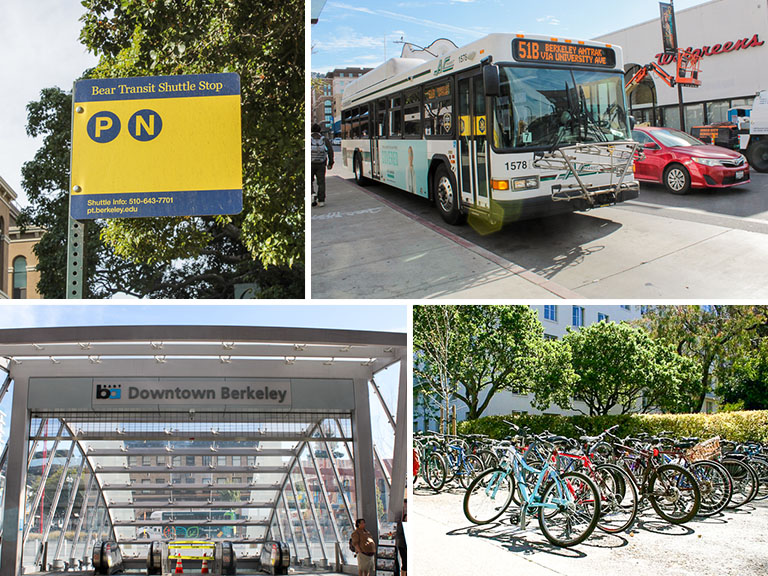
Admissions | Campus Life | Explore Campus | Fall Start | New Students | Spring Start | Student Experience
Get Around Berkeley & the Bay
Navigating the streets of Berkeley and beyond doesn’t need to feel difficult. There are many options for you to get from point A to point B, whether it be renting a car or bike, or hopping on a public mode of transportation. Here’s a guide to make urban travel easier.
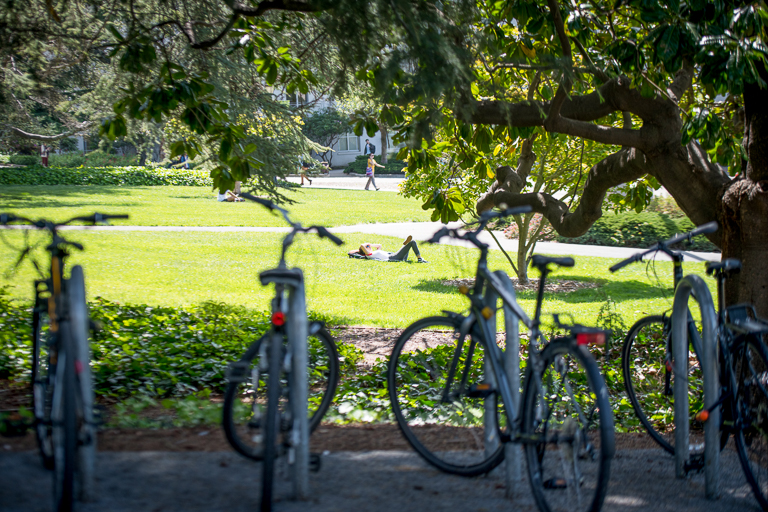
Students relaxing near a campus bike rack.
BART
BART (Bay Area Rapid Transit line) is a public train system that takes you all over the Bay Area from Richmond to San Francisco to North San Jose. Cal Students are administered EasyPass Clipper Cards during GBO when they receive their school IDs that allow them to access BART stations and all other AC Transit modes of transportation. The nearest station entrances to Berkeley are Downtown Berkeley (2160 Shattuck Ave.) and North Berkeley (1750 Sacramento St.).
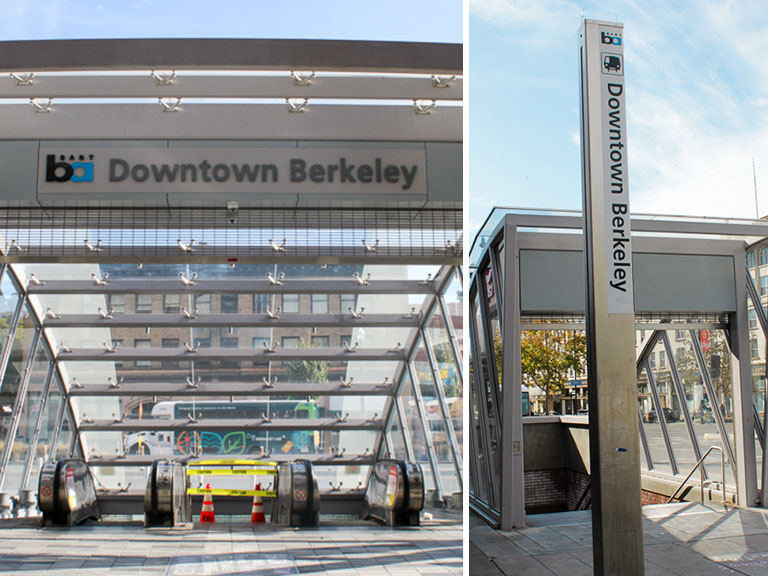
The Downtown Berkeley BART Station entrances, on opposite ends of Shattuck Ave.
How to Ride BART
Once you walk down the stairs into the station, head to the nearest Clipper Card Add Value Station and add the amount required for where you want to go. The amounts are posted on a board in the station. BART has an app that tells you where each train on each platform is going and when it is coming. You can also check this on Apple Maps. The trains are color-coded and the destination labeled on the train is the last stop of the line. Check the system map for all of the stops on a particular line, particularly to find yours. You then tap your Clipper Card on a blue pad that has the Clipper Card insignia at the entrances to enter. Hop on your line. After you arrive, you must tap your Clipper Card on a blue pad at the exits one more time, which charges you for the trip.
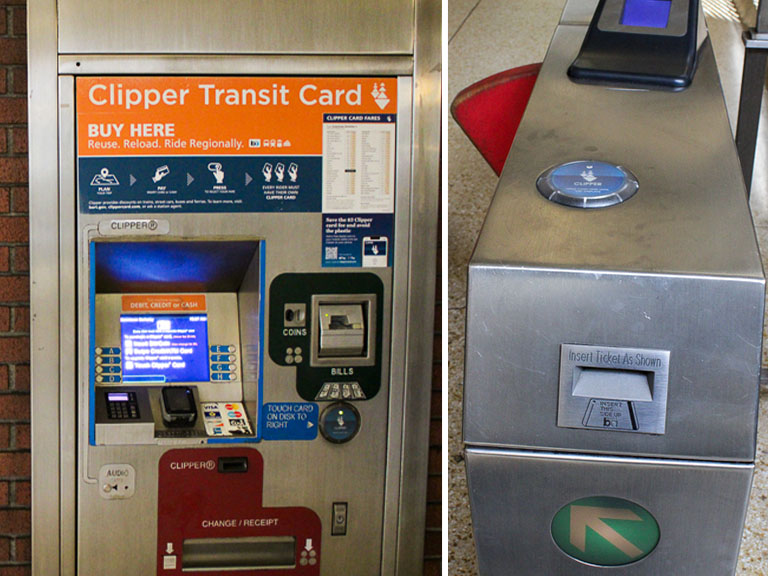
Left: Clipper Card loading areas. Right: Entrance to the BART trains where you tap your Clipper Card.
To summarize:
- BART allows you to travel extensively around the Bay Area
- Load money onto your student-administered Clipper Card to access the train platform
- Plan your trip ahead of time for a smooth travel experience using the system map and BART app
AC Transit Bus & Bear Shuttle
The AC Transit buses are the easiest way to navigate around Berkeley. Like BART, you use your Clipper Card to ride. A quick tip is to add it to your Apple Wallet. You don’t have to add money to your card for bus travel because transportation is covered in your cost of attendance. The AC Transit app is a great way to navigate from your location to where you want to go, as are Apple and Google Maps. Plug in your destination then walk to the closest appropriate bus stop. It’s important to make sure the bus is going in the direction you’re headed because oftentimes there are stops across the street from each other going in opposite directions. When the bus is arriving, hold out your arm to flag them down to notify them that you want to get on.
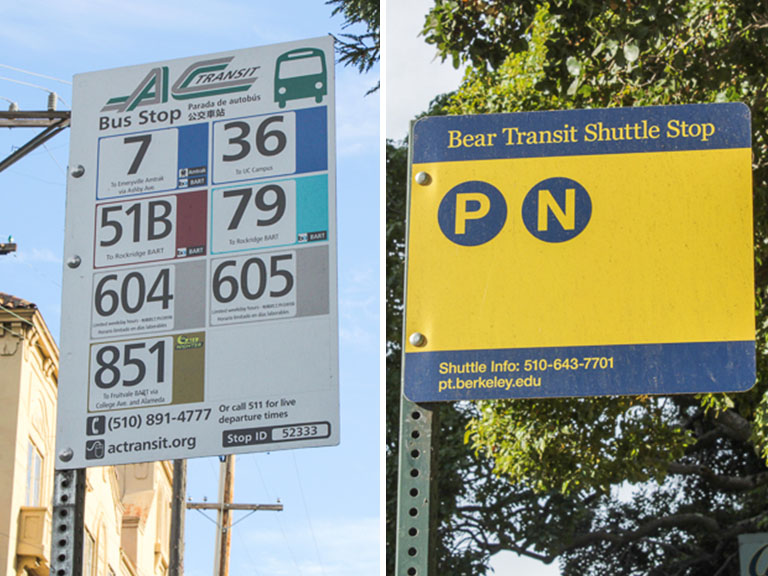
AC Transit and Bear Transit Shuttle stop signs.
Tap your Clipper Card on the pad right when you step on. When your stop is coming up, usually named by a junction between two streets, pull on the cord that lines the walls of the bus or press the stop button on one of the poles to request a stop. Two of the most common bus lines are the 51B and 79. The 51B goes from Rockridge to the Berkeley Marina and back again. It runs down College Ave and the Southside of campus all along Bancroft as well as downtown on Shattuck. The 79 goes from Rockridge up Piedmont and south of campus—similar to the 51B, except this line goes further on to Northside Berkeley instead of the Marina.

The 51B bus.
Bear Transit’s shuttles are another great way to navigate around campus. They also offer night shuttles, detailed in our “Late Night in Berkeley” article. The shuttle routes go all around the perimeter of campus, depending on which one you get on as labeled by letters. You use your Clipper Card to get on, similar to the city buses.
To summarize:
- Tap your Clipper Card to get on the bus
- Flag down the bus by waving your arm
- Bear Transit’s shuttles have additional routes around campus
Renting Scooters & Cars
For more individualized modes of transportation, there is an abundance of vehicles around Berkeley that can be rented. Scooter companies such as VEO and Superpedestrian’s Link are popular in the area. Download their apps which allow you to unlock and use the vehicle, typically by scanning a QR code. When you’re done, drop it off wherever that’s out of the way of cars and pedestrian traffic.
If it’s more suitable to get to your destination by car, try out GIG Car Share. They cover a large range of the Bay Area, called the HomeZone, and charge by the minute. Drive and park anywhere within this HomeZone. There’s also an option to prepay for a certain amount of hours. All you need is a driver’s license to pick up and drop off the car in the HomeZone. There’s no need to feed the meters in unrestricted zones, pay for gas, or cover their car insurance. It’s a great way to get around.
To sum:
- VEO and Link scooters are most common in the area
- Download respective apps to access vehicles
- Don’t leave GIG’s HomeZone
Rules of the Road
You can only drive scooters on bike paths, bikeways, and trails, but not on a sidewalk. It’s illegal to ride in crosswalks. There are fines if you don’t stick to the bike lanes or walk your wheels. You can’t exceed a speed of 15 miles per hour. All of the road rules that cars have to follow apply when riding a scooter. Pedestrian traffic has the right of way and must be yielded to. Riding with a helmet is highly advised, and a state law requirement for minors. Make sure to always park scooters upright and not in restricted zones.
Your Own Vehicle
Have your own bike, scooter, or car? Knowing where to store them throughout the day is important to know. The City of Berkeley has bicycle parking, stations, and lockers. On campus, there are bicycle racks spread out as well as bike cages and ten bike stations. In residential facilities, there are bicycle racks outside. It’s imperative that you respect the designated bike paths on campus. The other paths are only for pedestrians or cars. Berkeley has bikeways that span all across North Berkeley to the Marina and Southside. Berkeley has seven bike boulevards that are regarded as the best paths for cyclists. There are also tons of scenic cycling routes that are worth checking out.
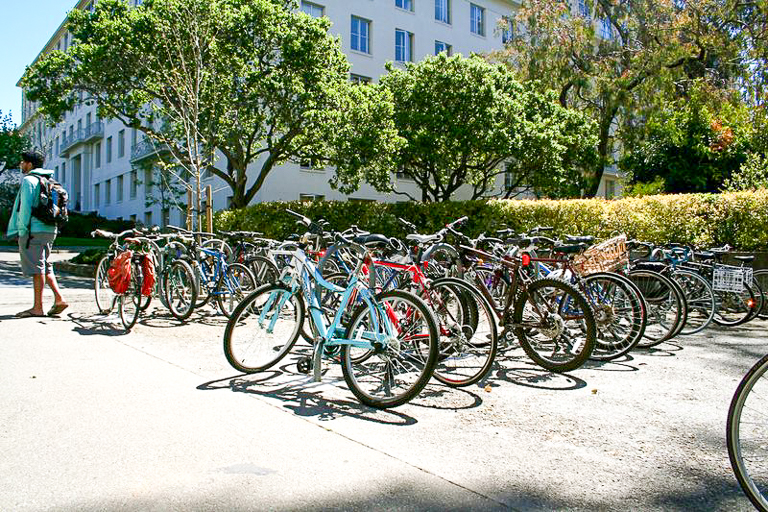
Bicycle racks on campus
Scooters are not allowed to be locked up to bus stop signs, disabled parking signs, trees, fire hydrants, or private property. It’s recommended to use a U-Lock to secure your vehicle to a bike rack or any of the bike cages on campus. Be sure to only ride in the bike lane, not the sidewalk, and always wear a helmet. All motorized vehicles are not allowed to be used while in residential facilities and only UL-certified vehicles (meaning it’s been nationally recognized as safe and free from significant risk) can be stored in them. Scooters above 45cc, mopeds, and motorcycles may not be stored in residential facilities. Permitted vehicles are typically stored in your room with you or if your building has a designated parking space for them inside.
For car drivers, there are multiple parking garages and spaces on and around campus. A permit must be purchased and visibly displayed while parked. There are multiple kinds of permits available, notably the Residence Hall overnight permits for students living in on-campus housing. Electrical Vehicle charging is available in select parking locations.
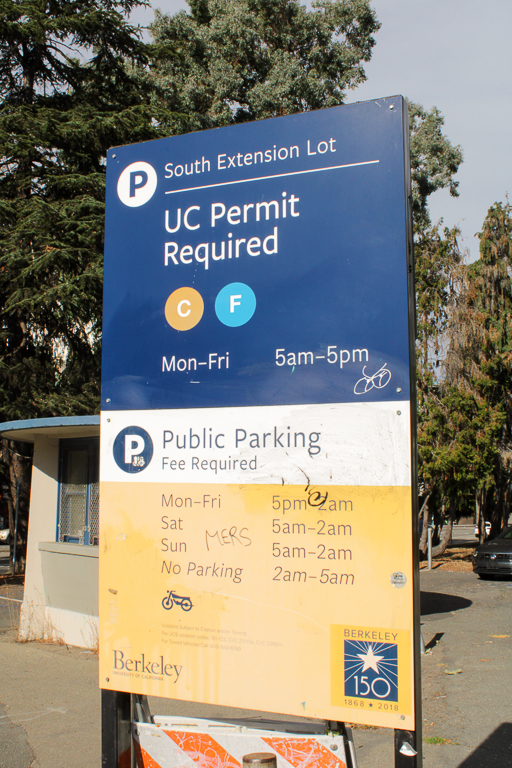
One of the available lots for cars with the appropriate permit.
To sum:
- No riding on the sidewalk
- Park in the correct areas and be sure your vehicle meets safety criteria
- Practice safety such as wearing a helmet and yielding to pedestrians
Happy Traveling!
Now that you’re an expert at navigating Berkeley and beyond to the greater Bay Area, you can explore so many fun places knowing how to conveniently get around. Consult this guide and its resources for any questions you may have while planning your next trip.
Preslee Vanlandingham is a fourth-year student at UC Berkeley majoring in English and minoring in creative writing.
Want More?
- Learn more about navigating transportation late at night
- Discover some Bay Area highlights to explore
- Visit fun places in Berkeley